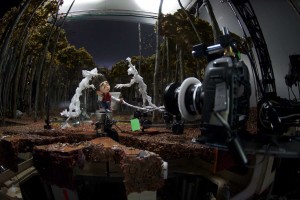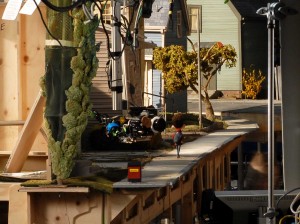
“The Canon EOS 5D Mark II has features that helped us to expedite the stop-motion animation process,” said John Ashlee Prat.
Prat, one of five lighting cameramen on the film, explained that in order to capture the more than 400,000 separate stop-frames needed to create ParaNorman, the film was divided among five camera teams and 50 separate units at LAIKA’s 151,000 square ft. studio. Each unit had its own shooting stage, sets, puppet actors, equipment (including Canon EOS 5D Mark II cameras), and a crew working on different portions of the film simultaneously. Director of photography Tristan Oliver supervised the daunting task of five simultaneous film units throughout the entire production.
Compact, lightweight and compatible with Canon’s wide selection of EF Series lenses, the Canon EOS 5D Mark II digital SLR camera is equipped with a 21.1 megapixel full-frame Canon CMOS image sensor and DIGIC 4 image processor for still-image capture in a number of RAW or JPEG modes and sRAW options.

Photography of a stereoscopic 3D film requires the capture of not one, but two frames – a left and a right image – 24 times for every second of screen time (in stop-motion animation that number is doubled to 48). The compact size of the Canon EOS 5D Mark II digital SLR camera (as opposed to traditional film cameras) helped facilitate the capture of the corresponding left and right images needed for 3D, especially given the miniature sets and puppets being photographed. Each 5D Mark II camera was mounted on a computer-controlled motorized horizontal slider, which moved the camera first right and then left for sequential capture of all the necessary 3D frame pairs.
“The slider is necessary because we can’t put two cameras side-by-side to successfully photograph little 8- to 12-inch puppets in a miniature world,” Prat explained. “We have to use the inter-ocular distances appropriate to that world in order for it not to look miniature.”
“The self-cleaning sensor feature of the Canon EOS 5D Mark II saved us a lot of time because we didn’t need to take the lens off to clean the sensor,” Prat added. “We are rolling our current fleet of 5D Mark II cameras on to our next production, although not for principal photography. Instead they will be used to support all the other departments for their photographic needs. Principal photography will be done with EOS 5D Mark III cameras, which feature a live view that’s two stops better than the original Mark II’s, and that’s even better for us.”





